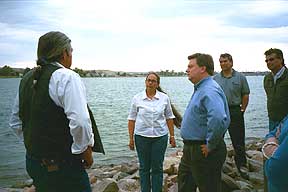 About ACHP
About ACHP ACHP News
National Historic
Preservation
Program
Working with
Section 106
Federal, State, & Tribal Programs
Training & Education
Publications
Search
Home
Hearing Held on Federal Management of Missouri River Historic Properties
For more information, contact Don Klima, (202) 606-8503,
dklima@achp.gov, or
Margie Nowick, (303) 969-5110, mnowick@achp.gov
FOR IMMEDIATE RELEASE
June 13, 2002
WASHINGTON—A hearing was held yesterday on the Army Corps of Engineers' management of historic properties along the Missouri River in Montana, North Dakota, South Dakota, and Nebraska.
Indian tribes, agencies, organizations, and the public were invited to speak at the hearing, which was hosted by the Advisory Council on Historic Preservation (ACHP) and attended by the U.S. Army Corps and the Department of Defense.
ACHP will accept written public comments on the Army Corps of Engineers' management of historic properties along the Missouri River until the close of business June 26, 2002. Comments should be addressed to Don L. Klima, Director of the Office of Federal Agency Programs, ACHP, 12136 West Bayaud Avenue, #330, Lakewood, CO 80228, or e-mailed to mnowick@achp.gov.
 Hearing
participants at the Missouri River. From left to right: Ellsworth Chytka,
Yankton Sioux Tribe; Pemina Yellow Bird, Mandan, Arikara, and Hidatsa
Nation; Philip Grone, ACHP member designee for Department of Defense;
Pem Hall, Corps of Engineers Omaha District Tribal Coordinator; and Mike
Kaczor, U.S. Forest Service Federal Preservation Officer.
Hearing
participants at the Missouri River. From left to right: Ellsworth Chytka,
Yankton Sioux Tribe; Pemina Yellow Bird, Mandan, Arikara, and Hidatsa
Nation; Philip Grone, ACHP member designee for Department of Defense;
Pem Hall, Corps of Engineers Omaha District Tribal Coordinator; and Mike
Kaczor, U.S. Forest Service Federal Preservation Officer.
The hearing, held in Pierre, South Dakota, is part of ACHP's review of the Army Corps' historic preservation program for the Missouri River Mainstem System, which consists of six dam and reservoir projects that provide hydroelectric power, flood control, water supply, recreational opportunities, and other functions.
Indian tribes, State Historic Preservation Officers, preservation groups, and the public have expressed concern about the effects of the current and proposed operation of the Mainstem System on historic properties and sacred lands.
"This hearing provides a forum for the public to raise issues of historic preservation for consideration by the various agencies involved," said John L. Nau, III, ACHP Chairman. "It also provides the ACHP with information necessary to determine the best recommendations for this program."
At its August 2002 business meeting, ACHP will recommend to the Secretary of the Army ways that the Army Corps can improve the effectiveness, coordination, and consistency of its historic preservation program.
Widespread erosion, vandalism, and recreation development from the Mainstem System are among the impacts that have threatened many of the thousands of historic properties on the Army Corps' land.
Properties include intact prehistoric sites such as fortified village sites, campsites, prehistoric and historic cemeteries and burial mounds with hundreds of human graves, historic fort and battle sites, sites visited by Lewis and Clark and other early explorers, and many sites of religious and cultural significance to Indian tribes.
Many of the 6,000 miles of the reservoirs' shoreline are adjacent to or within the exterior boundaries of several Indian reservations, including the Three Affiliated Tribes, Standing Rock Sioux Tribe, Cheyenne River Sioux Tribe, Lower Brule Sioux Tribe, Yankton Sioux Tribe, and Fort Peck Tribes.
ACHP, an independent Federal agency, serves as primary policy advisor to the President and Congress on historic preservation matters and oversees an administrative review process that requires Federal agencies to consider historic properties when planning projects. ACHP is headquartered in Washington, D.C., with an office in Denver, Colorado.
###
Updated April 17, 2003